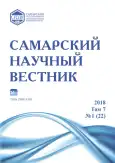Министерские разногласия и давление на Госплан в советской экономике в начале 1950-х годов
- Авторы: Захарченко А.В.1
-
Учреждения:
- Самарский филиал Московского городского педагогического университета
- Выпуск: Том 7, № 1 (2018)
- Страницы: 220-224
- Раздел: 07.00.00 – исторические науки и археология
- URL: https://journals.rcsi.science/2309-4370/article/view/25375
- DOI: https://doi.org/10.17816/snv201871217
- ID: 25375
Цитировать
Полный текст
Аннотация
В статье на основе архивных документов анализируется механизм выработки компромиссных решений при обсуждении плана развития народного хозяйства СССР на 1951-1955 гг. Анализ источников (записок руководителей министерств в правительство, справок Госплана и его проектов развития советской экономики на период 1951-1955 гг.) показывает наличие разногласий между центральным органом планирования и хозяйственными ведомствами. Позиция Госплана, который стремился к составлению сбалансированного плана, заключалась в распределении ресурсов и хозяйственных обязательств между министерствами. Министерства со своей стороны склонны были предлагать более низкие цифры роста производственных показателей и завышенные объемы ресурсов на выполнение планов. Расхождения в позициях регулировались специальной межведомственной комиссией по разногласиям, предложения которой брались за основу правительством и Госпланом для внесения поправок в текущее и перспективное планирование промышленного развития СССР. Результаты исследования позволяют сделать вывод о том, что плановая экономика в действительности являлась экономикой «согласований». В этой системе директивы правительства рассматривались как результат межведомственной борьбы «плановиков» и «производственников», в которой Госплан уравновешивал амбиции министерств. Однако активный «лоббизм» министров ограничивал возможности «плановиков», о чем свидетельствуют документы комиссии по разногласиям.
Ключевые слова
Полный текст
Открыть статью на сайте журналаОб авторах
Алексей Владимирович Захарченко
Самарский филиал Московского городского педагогического университета
Автор, ответственный за переписку.
Email: zaharchenkoav@gmail.com
доктор исторических наук, доцент, заведующий кафедрой истории, международного права и зарубежного регионоведения
Россия, СамараСписок литературы
- Российский государственный архив экономики (РГАЭ). Ф. 4372 / Государственная плановая комиссия при Совете Министров СССР. Оп. 97-99.
- Пихоя Р.Г. Советский Союз: история власти. 1945-1991. Новосибирск: Изд-во «Сибирский хронограф», 2000. 684 с.
- Попов В.П. Экономическая политика советского государства. 1946-1953 гг. М.-Тамбов: Изд-во Тамбов. гос. ун-та, 2000. 222 с.
- Хлевнюк О.В. Советская экономическая политика на рубеже 1940-1950-х гг. и «дело Госплана» // Отечественная история. 2001. № 3. С. 77-89.
- Хлевнюк О.В., Горлицкий Й. Холодный мир: Сталин и завершение сталинской диктатуры. М.: РОССПЭН, 2011. 231 с.
- Данилов А.А., Пыжиков А.В. Рождение сверхдержавы: СССР в первые послевоенные годы. М.: РОССПЭН, 2001. 304 с.
- Белова Е.Б. Стихия плана: практика работы Госплана СССР в первой половине 30-х гг. // Экономическая история: Ежегодник. 2001. М., 2002. С. 579-606.
- Некрасов В.Л. Реформа Госплана СССР 1955 г.: разработка новой модели планирования экономики // Вестник ТГУ. 2013. № 368. С. 99-103.
- Некрасов В.Л. Должность председателя Госплана СССР в системе высшего политического руководства (1955-1964 гг.) // Гуманитарные науки в Сибири. 2012. № 4. С. 66-69.
- РГАЭ. Ф. 4372. Оп. 97. Д. 484.
- РГАЭ. Ф. 4372. Оп. 97. Д. 116.
- РГАЭ. Ф. 4372. Оп. 99. Д. 127.
- РГАЭ. Ф. 4337. Оп. 97. Д. 484.
- РГАЭ. Ф. 4372. Оп. 99. Д. 147.
- РГАЭ. Ф. 4372. Оп. 99. Д. 197.
Дополнительные файлы






